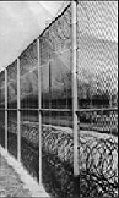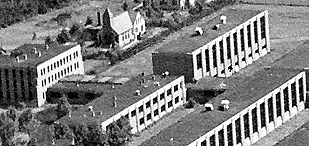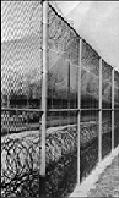DEVIL'S ISLAND
Huge cubical structures, graceless red brick boxes, miles of barbed wire stretched four or five yards high and electrified here and there -- the exterior serenity of the penitentiary complex of Rikers Island is disturbed only by the incessant comings and goings of the Department of Correction bus or of cars transporting prisoners or employees. On one side it is very close to La Guardia Airport, so at irregular intervals there is the furious noise of planes landing or taking off. Then the walls of Rikers vibrate and conversations stop, for we can neither listen nor hear ourselves speaking.
It is forbidden to walk between the buildings. Security and identity controls begin before the bridge, the one access route tying the prison to another world, in this case Queens. From the first stop onward, visitors have to accept being at the mercy of constraints and controls, state their business, get a clearance, open their bags, and so forth. This routine sometimes takes a long time. It is a necessary verification, it is quite legal to demand it, and it expresses the reality of the place very quickly.
Rikers Island razorwire
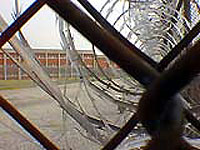 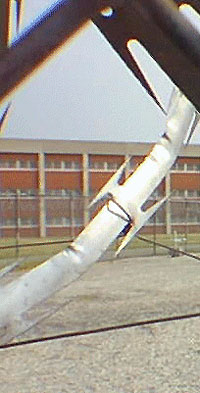
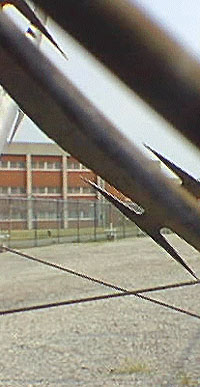
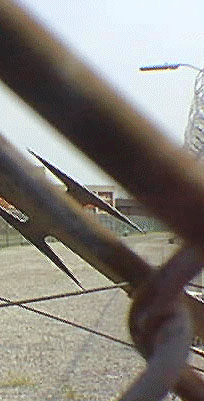
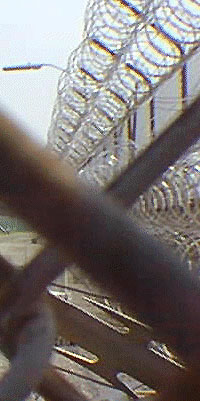
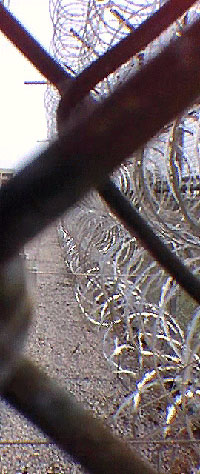
NYCHS photo images ©
The Raphael book has no images illustrating the text. For design and informational purposes, relevant images have been added and captioned by the webmaster.
|
I sometimes see the wardens having to show their credentials to their own employees. In the context of Rikers, as in every prison, this is a very banal gesture and easily explained. Here is the somber monotony of a world created to lock up everything with security, suspicion and certitude, to put everything in boxes and pigeonholes, far removed from every kind of fantasy or initiative. Rikers is a kind of global village, very precisely organized under a mountain of laws and rules, but also designed to be self-sufficient and self-contained. An electrical blackout, for example, like the one that darkened all New York in 1977, would not affect us here. We have in place the means to carry on and survive. In this "total institution," this massive drive for autonomy adds to the isolation. The prison, in thought and action, is truly a distant world, set apart, clothed in armor.
Beyond the prison buildings there is silence . . . . disturbed only by the passage of cars and airplanes, birds of all kinds, mostly gulls, who are taking possession of the place. They are at home. . . Sometimes you can see a spectacle as beautiful as it is unusual: pheasants of magnificent color and grace. They are indifferent to what is going on around them; their domain remains inviolate. It is only the people here who are penned up.
Rikers Island is a mushroom prison. It is part of the largest municipal detention system in the world. Its mission, according to a Department of Correction pamphlet, "is to provide custody for persons in detention and individuals sentenced to one year or less, in an environment which is safe for staff and inmates and which is consistent with constitutional and professional standards." When I came here, nearly 10 years ago, the number of prisoners was a little more than 6,000, not counting those elsewhere in the boroughs of Queens, Brooklyn, the Bronx, and Manhattan, each having one or several prisons of slightly smaller dimensions. Today the number has almost tripled.
Besides the new buildings, the prefabricated blocks are a sign of the overflowing prison population. These are a kind of elongated rectangular trailer attached to the existing buildings. They contain long corridors and dormitories lined with dozens of camp cots. Every building has a name: NYC Correctional Institution for Men, also called C 76; "Women House"; "Adolescent Reception Center," also called C 74; "Anna M. Kross Center," also called C 95; "North Facility"; "East Facility"; and so on. I should not fail to mention the two ferryboats moored along the Rikers Island quay . . . . . These ferries are the last resort in the struggle to cope with the housing crisis in the prison. They shelter those with the lightest sentences, and those who are already on work release.
Originally Rikers Island, located in the East River between Queens and the Bronx, belonged to the Ryker family, who were early Dutch immigrants. . . . the 90-acre island [was sold] to the city [around] 1885. As time progressed, so did the development of the island. Landfill has more than quadrupled the size of Rikers Island . . . .
One of the oldest establishments on Rikers Island is the HDM (House of Detention for Men). It was built in [the 1930s] and
now bears the name James A. Thomas Center, for a recent warden. It is a very antiquated structure, and some people in the Department of Correction still have vivid memories of the riots that have taken place within its walls. At times it has also had a reputation for extreme severity. The prisoners there are divided among eight large blocks of three level stacks joined by staircases. Completely enclosed by movable bars at each end of the blocks, the cells are just big enough for a bed, a small iron table fixed to the wall, a washbasin and a toilet. There are also the various solitary cells ("bings"), an important part of HDM's function. The prisoners who are guilty of infractions or violations mostly end up in these bings, where, obviously, the restrictions are much greater, especially as regards schedules and activities. They are sent there from all the [municipal] prisons in New York [City].
All the blocks in HDM open on a single, long corridor running along one side, the necessary route and place of encounter for everyone bound for the mess hall, the yard, the visitors' room, and so on. This corridor is the town square of this village of 1200 prisoners. It is there that many of the newcomers immediately fuse into one, and where people meet each other, for good or ill.
One finds a very different atmosphere in Building C 95. It is a much newer building, lacking any sense of unity, with long spaces that could easily be compared to the long corridors in the subway. By modern standards of prison construction, C 95 is certainly very acceptable. However, because of the size of its spaces, the time required to move from one place to another, and the number of people there for mental observation, it is objectively more anonymous than other prisons; it certainly demands a totally different and difficult human adaptation. In every way, within the very precise rubric of "minimum standards for the care, custody, correction, treatment, supervision and discipline of all persons held in the custody of the Department of Correction of New York," it is clear that every building has its own style, tradition, and spirit. Each is made up of a group of imponderables, of a thousand factors inherent in every collectivity, especially what each person, willingly or not, brings to it.
In every prison on Rikers Island, no matter which one, what strikes one first of all is the noise. It is like the noise of a railroad station; more often than not it hits you like a blow on the head. There is the noise of the airport nearby, of the planes taking off, the objects of all our dreams, symbols of adventure, of freedom and of escape. There is the noise of the bars opening and closing, the noise of carts rolling through the corridors, the noise of television sets and radios. It is the noise of this iron world, the sound of handcuffs and of heavy keys that hang like bunches of grapes at the belts of the guards, the noise of whistling and shouting -- ultimately, the corrosive "noise" of fixed stares. For, as you learn very quickly here, there are silences that shriek.
Even after all these years, I am still struck by the sight, here and there, of bars that are worn, polished, shiny. They are big, solid things. What if they could see, if they could speak? Just a look, in there, is a whole message. They are the fascinating, obstinate, silent witnesses of millions of longings, frustrations, waiting. What thoughts have met here, and go on doing so! There is no end to it.
In the same vein -- though this takes me outside of Rikers -- I remember visiting someone I had known on the street. . . [Bill] was not a prisoner. He lived in Manhattan; he had a little apartment of his own. He drank a lot, smoked a lot, but he was lucid. He said to me one day, "I can't allow myself to hope, because hope is a form of joy. And joy isn't in my nature. It isn't possible for me." And what he did, what he said was the only thing he was capable of doing, was to walk in his squalid little kitchen, up and down, always the same route, so much so that the floor was marked by the path he had worn. His feet had left a trace on the floorboards, a line right down the middle.
There, it was a mark on the floor. In prison, it is the hands on the bars. Marked floors, worn bars, these are the deep wounds of a world that is stopped, alienated, restrained, run aground. These bars, these steps often fill my dreams.
In every building, in the offices of the Security Department, you can find, assembled like a kind of inventory, all the things that may have been found during searches in the cells and elsewhere -- arms of all types, sharpened pieces of metal, cutting blades, nails, as well as packets of confiscated drugs, cleverly concealed between pages of a magazine, balls of plastic explosive, and so on. It is a very forceful expression of the kind of aggressivity and despair that can be at work at the back of people's minds in this place. It is hard not to see it, hard to ignore it.
But without wishing to minimize anything or justify the violence that is hidden, latent, and sometimes explodes disastrously -- there is no communicating the horror, no understanding it, it is literally insupportable. It sums up the struggle and strife in this island which, after all, is not so far from that other island bearing the "lady with a torch," with its message of liberty, the phantom and dream of day after day, night after night. That one word, that simple and very difficult reality of a here and now to be changed, which releases an extraordinary inventiveness, a polarization of energies, of patience, of caring, of extreme resourcefulness, betrays itself in these fabricated, transformed objects which are a real trip to the kingdom of escape, the realm of desire: homemade shields, I.D., the panoply of the C.O. (correction officer), gadgets of every kind. . . .
Nine out of ten prisoners on this island are black or Spanish-speaking people from countries of Central and South America, most of them without papers. All that many of them have in common is that they come from the most deprived sectors of the big cities, from broken or non-existent families, from a subterranean universe or one open only to unemployment or drugs. "You grow up too fast," one of them says. They know the street infinitely better than the school bench. Apart from that, everything divides them, to the point of caricature or legend. There are the leaders, those who make the laws, and there are the powerless. There are the whites and the blacks, the Puerto Ricans and the Latinos, those who speak English and those who know only Spanish, those who can improve their rations at the commissary and those who never have a penny in their pockets, those who have families and one or two friends and those who come from too far away to have any visitors, those who can make telephone calls because they know someone living in New York and those who have no one they can call.
Given the rapid rotation of people, a peculiar feature of a house of detention . . . . is that socioeconomic programs, which are often quite modest because of a lack of personnel or money, also come into collision with a variety of obstacles: movements to court, to the clinic, to the commissary, countdowns, searches, alarms, and so forth. These programs have to be continually relaunched and revived so as not to be pulverized by impossible scheduling, sudden emergencies or a change of prisoners. Everything here is governed by logistics and precautions; security is the master word, familiar slogan and imperative of every prison.
Separation, inactivity, and boredom are the law of the society, of the subculture -- seen, for example, in the tattoos. "We're all in the same boat," says a Colombian, "but in prison the presence of a stranger is resented more than anywhere else." Solitude is all the more oppressive for a South American because his family is very far away, he has little money, receives very few visits, normally cannot telephone outside New York and often has only the vaguest understanding of the workings of the American judicial machinery.
Sometimes there is an eruption of racism as well. What we see on the streets and in the larger society of New York has very strong echoes in the prison. Being black, being white -- I have learned here what the juxtaposition of those two words can arouse, the sensitivity they express and how the responsibility of all of us is bound up in them. But if there is one unifying circumstance to be discovered in sorting out the precise reasons why a man or woman is imprisoned here, it is poverty. The majority of those who are prisoners here, whether black, yellow or white, are the real witnesses of the immense gulf in our world caused by money. Very often the word that covers everything -- broken families, drug addiction, rootlessness, all the failures of education or housing -- is poverty. . . .
In this rapid and very brief overview of the prison, I have not yet spoken of my principal assignment at Rikers -- the hospital. It is, at the present time (1989), undergoing a considerable change owing, as everywhere in the prison, to overcrowding. (New York City jails are already filled to 102.8 percent of capacity.) The hospital, built in 1932, was, in fact, the first building [in the modern prison complex] on the island. It had a capacity of 184 mental and medical non-emergency cases, housed on six levels reached by an elevator. Now there are also three large dormitories, which have been put up nearby, and which are occupied only by the sick and injured. The old hospital is inhabited by another category of prisoners -- those on work release or already sentenced, who are not ill. That often discordant situation of non-ill inmates is the result of emergency measures in response to imperative court orders concerning the permissible capacity of a space and the accommodation of prisoners.
A special case is Dorm 18 E, where there are about 30 inmates with AIDS, the disease which spreads so much terror, the evil of the century. (There were 3,190 deaths of AIDS in New York City in 1987.) Dorm 18 E has its programs, its treatments, its meetings. There are efforts at comfort. The inmate population changes constantly. The disease has forced me and many other people here to witness a lot of human suffering and dying. For example, there was Nicholas, who said to me a few days before he left this world, "There ought to be something done so AIDS patients could die outside, not in prison. If I had a choice, I'd rather die in the East River, not in here." Being a prisoner with AIDS is one of the ultimate screams emanating from Rikers.
Overpopulation, mutinies, escape efforts, suicides, illness, fights and murders all happen in the midst of the routine and the daily round of the "total institution." Life in the prison sometimes appears to be nothing but a concentration of disasters. Outside, you read prison stories, you listen, you watch what is going on, you get worked up when you have to, but you take care always to keep your distance and your separateness. You clutch at the lifeline. You don't want to end up on the garbage dump. It is the survival instinct of the society that surrounds Rikers Island with a wall of indifference and fear much thicker than all the water and bars around it.
Why is the prison milieu like this? What are we creating here? It is not at all natural for a society to question itself about what it is hiding and covering up. Helping criminals, or those presumed to be such, appears to mean first of all doing everything possible to isolate and immobilize them, to suppress the danger that they represent. The arms employed are distance, forgetfulness and still more forgetfulness. It is understandable. Why look for shadows when there is so much sunshine?
But what happens at the prison gate, at the moment they reach the other side of the bars? Memory does not leave a person instantaneously, as he or she emerges, the survivor of a long or short winter of incarceration. In prison these people have learned something more about the human condition. It is very hard to bury a past unhappiness, to get beyond it, and its traces become indelible when they are reflected in the eyes of others. In Kafka's dictionary, which reflects a world not very far removed from this one, nothing is said about the word pardon. After all, society, with its tics and its choices, is all of us. It has the faded, gray, bitter color of prejudice and the spontaneous sense of gestures of rejection. It knows right away how to keep its eyes averted. Health, as someone says, is a state of mind. Sometimes it is also an illusion. The stories that follow are stories of real people.
